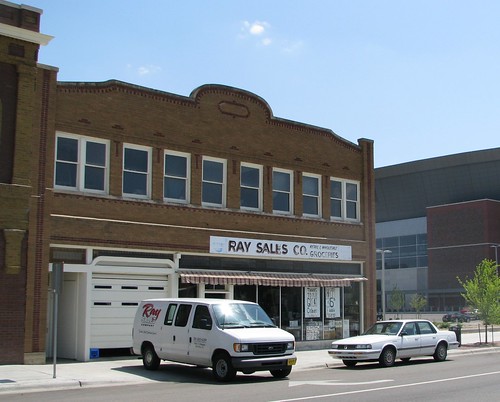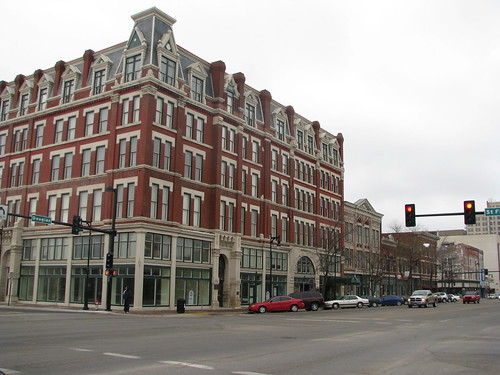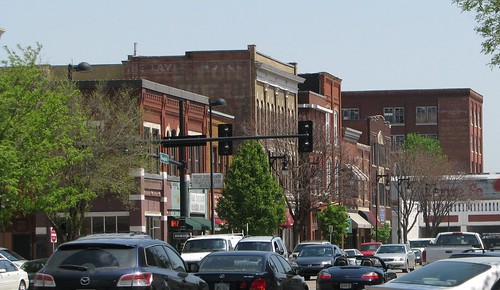Kansas is committed to historic preservation
Wichita has a downtown grocery store.
I came across it while out for a walk in the eastern part of downtown, near the recently opened Intrust Arena. (Some people go to the Y or the hotel exercise room. I walk through downtowns and historic neighborhoods.)
The store would be easy to miss. It's in an old two-story building, a block off of Douglas, the main east-west thoroughfare through downtown, across the street from the city bus terminal. It's also close to the newly opened Intrust Arena, and as a result it came close to not being there at all.

Ray Sales Co.'s sign announces retail and wholesale groceries. The retail part is a small storefront (maybe 20x20) that offers a selection of basic food and home necessities, more variety than you'd find in a convenience store. It's just a block away from the historic Eaton Hotel, which has been restored and converted to residential use, and just a few blocks more from the lofts in the warehouses of Old Town and downtown office buildings that city officials hope to redevelop as residences.
 I stopped in for a bottle of Diet Coke and spoke briefly to the lady behind the counter. In response to my comment about the arena being nearby, she told me that the county had wanted the land for the arena development, but preservationists had identified the building as historic, which prevented the building from being knocked down and the store from being displaced from its home for 36 years.
I stopped in for a bottle of Diet Coke and spoke briefly to the lady behind the counter. In response to my comment about the arena being nearby, she told me that the county had wanted the land for the arena development, but preservationists had identified the building as historic, which prevented the building from being knocked down and the store from being displaced from its home for 36 years.
While I was in the store, I witnessed the kind of personal service that small, family-owned businesses are renowned for. Customers from all walks of life were treated with kindness and respect, with extra assistance for those who needed it.
 Had it not been for the historical status of the Ray Sales building and the Eagle Hall Building next door, the county would have bought and demolished the buildings, and it likely would have been the end of the line for the small business, at least as a downtown grocery. It would have been hard for the grocery to find another affordable location nearby. Its customers -- downtown residents and workers, bus riders passing through the station -- would have lost a valuable resource. You're not going to find a box of marble cake mix or a 55 cent can of pop at the Intrust Arena concession stand, which isn't even open most days.
Had it not been for the historical status of the Ray Sales building and the Eagle Hall Building next door, the county would have bought and demolished the buildings, and it likely would have been the end of the line for the small business, at least as a downtown grocery. It would have been hard for the grocery to find another affordable location nearby. Its customers -- downtown residents and workers, bus riders passing through the station -- would have lost a valuable resource. You're not going to find a box of marble cake mix or a 55 cent can of pop at the Intrust Arena concession stand, which isn't even open most days.
Tulsa saw this happen with the Denver Grill, one of Tulsa's oldest restaurants, and the Children's Day Nursery, founded in 1916, which were both demolished to make way for the BOk Center, even though the arena could have been situated to leave those two buildings, at opposite corners of the site, in place. The Denver Grill relocated to the once-and-future Holiday Inn at 7th and Boulder, but the move from a corner diner to the second-floor of a hotel cost it visibility and customers, and it's no longer in business. The Children's Day Nursery, providing convenient day care near the civic center and the city bus terminal, no longer appears to be in business anywhere.
It amazed me that historic preservation laws in Kansas were sturdy enough to stop a local government from taking land for a publicly owned facility, so I did some research.
In 1977, while Tulsa leaders were still busily demolishing historic buildings and neighborhoods in the name of progress, the Kansas Preservation Act became law, declaring that "the historical, architectural, archeological and cultural heritage of Kansas is an important asset of the state and that its preservation and maintenance should be among the highest priorities of government."
Every government action involving land -- whether a city or county's own project, or government approval for a private project (e.g. building permit, zoning change) -- within 500 feet of a place on the National or Kansas Register of Historic Places is subject to review by the State Historic Preservation Office (SHPO). If the SHPO finds that the project will encroach upon or damage historic property, the project can't go forward unless the local government determines, "based on a consideration of all relevant factors, that there is no feasible and prudent alternative to the proposal and that the program includes all possible planning to minimize harm to such property resulting from such use." Kansas courts have construed this requirement strictly: A city council can't just say, "we determine," and the project moves ahead. "Alternatives may not be rejected unless they present 'unique problems' or 'cost or community disruption' of 'extraordinary magnitudes.'"
The results are evident all over Wichita and on small town Main Streets across Kansas. While Wichita joined the urban renewal orgy of the '60s -- the scars are most apparent a few blocks north of Douglas and between Main and the Arkansas River -- the bleeding was largely stopped when the bill passed, and the kind of urban fabric that Tulsa lost long ago is still present in Wichita.
But the difference is not just one of laws. Kansas could pass a strict historic preservation law because Kansas leaders see the value of preservation. There is a presumption in Kansas in favor of preservation, a presumption that isn't widely held among Tulsa leaders. I wouldn't expect to see the sentiments expressed by the Wichita Eagle editorial board, in a November 15, 2006, editorial, expressed in our daily paper:
Some destruction of the old is unavoidable if Wichita wants to make way for new growth. But public officials also must make sure that these buildings - and their owners - get a fair hearing....Board members properly start from an assumption that old buildings are worth preserving....
Two buildings on the site stand out as worthy of preservation: The Ray Sales building at 206 S. Emporia and the Dancers Building at 200 S. Emporia. The county should try to find a way to incorporate them into the master plan. They're not directly in the arena footprint. And they have architectural character and charm that would help provide a visual link to the brick-and-gaslight feel of Old Town.
As this process goes forward, arena stakeholders must work to find the right balance between preservation and growth.
There will be tough decisions.Wherever possible, though, let's preserve downtown's history and character.
In city after city, state after state, preservation only caught on once local leaders with wealth and social influence (often, as in Savannah and San Antonio, the wives of prominent businessmen) adopted it as a cause. For whatever reason, that still hasn't happened in Tulsa.
MORE: Here's the section of the Kansas State Historical Society's website on the Kansas Preservation Act. Their guide to the Preservation Act has a good summary of the history of the law and how it is applied.
0 TrackBacks
Listed below are links to blogs that reference this entry: Kansas is committed to historic preservation.
TrackBack URL for this entry: https://www.batesline.com/cgi-bin/mt/mt-tb.cgi/5590

